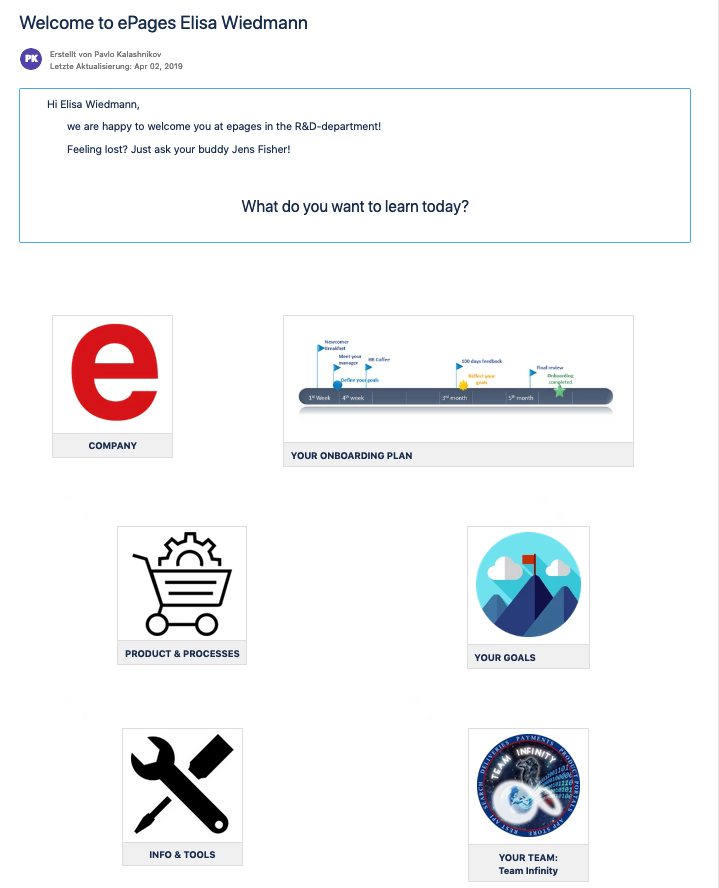Shortly after joining ePages as a Scrum Master I was introduced to the ePages Hackathon. A hackathon is a merge between “hack” and “marathon”, and is a collaborative event to develop software or “hack” any other topic. At ePages it is a two-day event, where all employees sign up for different topics and work exclusively on their project in a cross-functional team.
What does a non-tech Scrum Master do during a hackathon?
Am I supposed to learn coding? Do I have to walk around to bring cookies to the teams? A hackathon is always a good opportunity to have a look outside the box of your usual working environment. This applies to developers as well as to non-technical team members. So our Scrum Master team decided to work together with HR on the onboarding process of ePages.
To make sure that our ideas for improvement are really helpful for new employees, we used the design thinking method to shift our focus from our own to the view of a newbie.
First, we took the perspective of the new employee and collected what they see, hear, feel, and need. This resulted in an enormous amount of stickies. We felt overwhelmed and lost in the variety of topics, as often happens in creative processes. But when we boiled everything down to the definition of our typical employee it suddenly all made sense.
Here is our user story: The excited but also insecure new employee has a need for social acceptance, structure, and success, because it is more important to feel self-effective than getting pure information.
Social acceptance is a key element
This user story totally resonated with me, because this was exactly how I felt, when I started: I was happy and eager to work on the new job. At the same time, everything was new. I was often insecure, because I did not yet know the “unwritten rules” in the company, and most of the colleagues were unknown to me. I was overwhelmed by all the new information. Sometimes my head was just full of all the stuff I was listening to, and I really wanted to finally “do” something proactively.
While we were thinking about what we will need for an improved onboarding, it was also clear that we are already doing many things right: the awesome thing about onboarding at ePages is, that you immediately feel like you are part of the family. It starts with your trial day, at which you have the chance (and the challenge) to show your skills, but also get to know the future colleagues, your manager, and the teams you will be working with.
It did not feel like a trial day for me, because everyone was really open and welcoming. My colleagues offered help, and the team was really nice. When you finally have your first day at ePages, you don’t feel completely new, because you already know your team mates and they know you. And most important they have all agreed to hire you, so you don’t have to convince them of your competencies – a very good starting point for a Scrum Master especially. So, “feeling welcome” and “social acceptance” is checked off.
What about structure and success?
ePages gives you a lot of freedom to tackle things you would like to improve or change. Learning and development are always encouraged. Nevertheless, for some colleagues it might be difficult to go and ask for these things on their own.
One goal of our task force was to create a more structured approach to learn and realize your first successful steps. Furthermore, we wanted to structure the huge amount of information the teams collect about their work and our methods in a way, that it is easily accessible for a new employee. Information still is important, even if it is not the most important thing.
In order to have all information in one place, we created a space in Confluence. Uhh, boring – Confluence… That’s what you could see on all of our developer’s faces during the hackathon. But then we surprised them with a personalized version that’s automatically built via the terminal – ok, we got some help from our lovely developer-colleague Pavlo with that. That means, every new employee will have a personalized page with their own team section as a start page. On that page they can access all relevant information when they start with us.
Cross-functional teams rock
In the end, I was really satisfied with the outcome of the hackathon – not bad for a non-technical topic, right? Especially working in a cross-functional team with HR, a developer, system administrator, and my fellow Scrum Masters was a great experience. And of course, with three Scrum Masters in the team we directly created a Kanban board in order to continue working on this project. So stay tuned for more!



